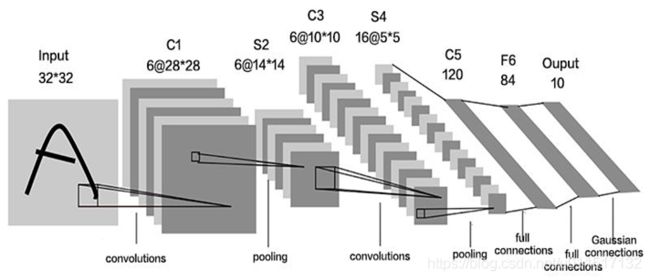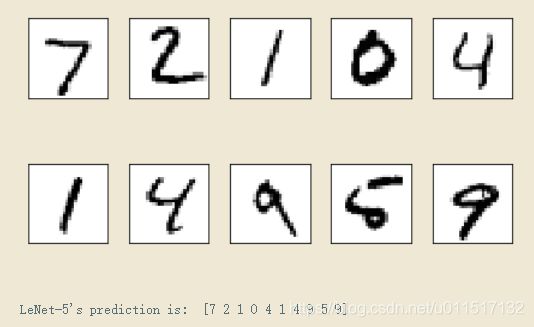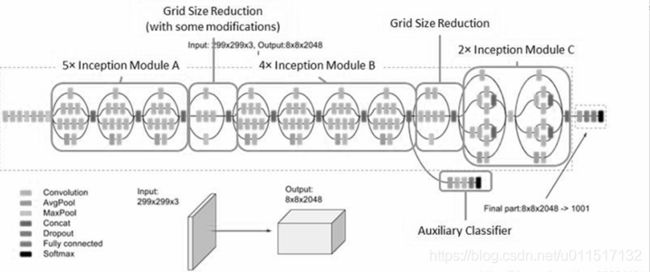卷积神经网络CNN相关模型python案例(LeNet-5、Inception_v3)
一、卷积神经网络CNN
卷积神经网络是通过卷积层(convolutions)和池化层(pooling)将特征从多个的通道(channel)生成Feature Map,再通过全连接网络(full connections)得到最终输出的一种神经网络结构。
卷积神经网络的结构通常如下:
输 入 − > ( 卷 积 层 c o n v o l u t i o n × N + 采 样 层 p o o l i n g ) × M − > 全 连 接 层 F C × K \mathrm{输入}->(\mathrm{卷积层}convolution\times N+采样层pooling)\times M->\mathrm{全连接层}FC\times K 输入−>(卷积层convolution×N+采样层pooling)×M−>全连接层FC×K
1. 卷积层(convolution)
一个卷积层是将深度为 d d d,每个深度上维度为 f × f f\times f f×f的矩阵(过滤器/卷积核)按照卷积运算的方式,作用在深度(通道)为 d d d,且每个通道上为一个二维 m × n m\times n m×n特征矩阵(Feature Map)上面,进行扫描运算。(还可以加上padding操作,防止矩阵越算算越小。)
具体示意图如下:
![]()
卷积层可以看做将原有矩阵特征通过卷积核生成新矩阵特征的过程。
2. 采样层(pooling)
Pooling层主要的作用是下采样,通过去掉Feature Map中不重要的样本,进一步减少参数数量。Pooling的方法很多,最常用的是Max Pooling。Max Pooling实际上就是在 n × n n\times n n×n的样本中取最大值,作为采样后的样本值。Max Pooling的示意图如下:

pooling层的通常具有以下作用:
对Feature Map进行压缩,保留主要的特征同时减少参数,提高模型泛华能力
增加特征的平移不变性(矩阵进行平移后旋转等操作时,对卷积层的运算结果影响不大。(详细可参考pooling的作用)
3.全连接层(Full Connection)
将Feature Map展开成一维后,连接全连接层。
关于卷积神经网络,网上讲解非常多,此处不仔细表述,推荐一个关于神经网络很通俗易懂的教程:零基础入门深度学习(4) - 卷积神经网络
二、LeNet-5的手写数字识别
LeNet-5出自论文Gradient-Based Learning Applied to Document Recognition,对MNIST数据集(mnist数据集下载地址)的分识别准确度可达99.2%。其网络结构为:
输 入 − > ( 卷 积 层 c o n v o l u t i o n + 采 样 层 p o o l i n g ) × 2 − > 全 连 接 层 F C × 2 − > s o f t m a x 层 \mathrm{输入}->(\mathrm{卷积层}convolution+采样层pooling)\times 2->\mathrm{全连接层}FC\times 2->softmax层 输入−>(卷积层convolution+采样层pooling)×2−>全连接层FC×2−>softmax层

使用深度学习工具tensorflow,编写LeNet-5结构,并对mnist手写数字集(mnist数据集下载地址)进行训练。其模型训练的python代码如下:
# -*- coding: utf-8 -*-
"""
Created on Tue Aug 20 17:51:50 2019
@author: nbszg
"""
#引入依赖包
import os
import struct
import numpy as np
import tensorflow as tf
import matplotlib.pyplot as plt
#数据加载函数
def load_mnist(path, kind='train'):
"""load mnist date
Args:
path: date path
kind: train or test
Returns:
images and labels
"""
labels_path = os.path.join(path,'%s-labels.idx1-ubyte'% kind) #标签数据
images_path = os.path.join(path,'%s-images.idx3-ubyte'% kind) #图像数据
with open(labels_path, 'rb') as lbpath:
magic, n = struct.unpack('>II',lbpath.read(8))
labels = np.fromfile(lbpath,dtype=np.uint8)
with open(images_path, 'rb') as imgpath:
magic, num, rows, cols = struct.unpack('>IIII',imgpath.read(16))
images = np.fromfile(imgpath,dtype=np.uint8).reshape(len(labels), 784)
return images, labels
path = 'D:/data/mnist/' #数据所在路径
X_train, y_train = load_mnist(path, kind='train') #训练集
X_test, y_test = load_mnist(path, kind='t10k') #测试集
#将label进行one-hot处理
def y_onehot(y):
"""one-hot option
Args:
y: labels
Returns:
one-hot label
eg:1->[0,1,0,0,0,0,0,0,0]
"""
n_class = 10
y_labels = np.eye(n_class)[y]
return y_labels
y_train_labels = y_onehot(y_train)
y_test_labels = y_onehot(y_test)
#网络权重变量
def weight_variable(shape):
"""weight_variable
Args:
shape: weight's shape with 4 dimensions
"""
initial = tf.truncated_normal(shape, stddev=0.1) #对变量进行初始化
return tf.Variable(initial)
#网络偏置项变量
def bias_variable(shape):
"""bias_variable
Args:
shape: bias's shape with 1 dimension
"""
initial = tf.constant(0.1, shape=shape)
return tf.Variable(initial)
#定义卷积层,padding='SAME'
def conv2d(x, W):
"""conv2d layer
Args:
x: input
W:weights
Returns:
conv2d output
"""
return tf.nn.conv2d(x, W, strides=[1, 1, 1, 1], padding='SAME')
#定义pooling层,采用max_pooling
def max_pool_2x2(x):
"""max pooling layer
Args:
x: input
Returns:
max pooling output
"""
return tf.nn.max_pool(x, ksize=[1, 2, 2, 1],strides=[1, 2, 2, 1], padding='SAME')
#超参
learning_rate = 0.0001 #学习速率
training_steps = 2000 #训练轮数
batch_size = 200 #批训练大小
display_step = 100 #展示步长
X = tf.placeholder(tf.float32,[None, 784]) #训练X
Y = tf.placeholder(tf.float32, [None, 10]) #标签y
W_conv1 = weight_variable([5, 5, 1, 32]) #第一层卷积参数5*5,输入通道1,输出通道32
b_conv1 = bias_variable([32]) #第一层卷积,偏置项输出通道32
W_conv2 = weight_variable([5, 5, 32, 64]) #第二层卷积参数5*5,输入通道32,输出通道64
b_conv2 = bias_variable([64]) #第二层卷积,偏置项输出通道64
W_fc1 = weight_variable([7 * 7 * 64, 1024]) #全连接层,64个通道图像变为1维,为7*7*64;设置1024个神经元
b_fc1 = bias_variable([1024]) #对应1024个偏置项
keep_prob = tf.placeholder("float") #drop_out概率
W_fc2 = weight_variable([1024, 10]) #全连接层变量
b_fc2 = bias_variable([10]) #全连接层偏置项
def conv_net(x, W_conv1, b_conv1, W_conv2, b_conv2, W_fc1, b_fc1, W_fc2, b_fc2, keep_prob):
"""conv_net model
Args:
...
Returns:
conv_net model prediction
"""
x_image = tf.reshape(x, [-1,28,28,1])
h_conv1 = tf.nn.relu(conv2d(x_image, W_conv1) + b_conv1) #第一层卷积层:relu函数
h_pool1 = max_pool_2x2(h_conv1) #第一Pooling层,因为pooling步长为2,因此图像矩阵变为14*14
h_conv2 = tf.nn.relu(conv2d(h_pool1, W_conv2) + b_conv2) #第二层卷积层:relu函数,因为pooling步长为2
h_pool2 = max_pool_2x2(h_conv2) #第二Pooling层,因为pooling步长为2,因此图像矩阵变为7*7
h_pool2_flat = tf.reshape(h_pool2, [-1, 7*7*64]) #改变最后Plooing层形状,为对应的7*7*64
h_fc1 = tf.nn.relu(tf.matmul(h_pool2_flat, W_fc1) + b_fc1) #全连接层
h_fc1_drop = tf.nn.dropout(h_fc1, keep_prob)
y_conv=tf.nn.softmax(tf.matmul(h_fc1_drop, W_fc2) + b_fc2) #最后softmax全连接层
return y_conv
y_conv = conv_net(X, W_conv1, b_conv1, W_conv2, b_conv2, W_fc1, b_fc1, W_fc2, b_fc2, keep_prob)
cross_entropy = -tf.reduce_mean(Y*tf.log(tf.clip_by_value(y_conv,1e-11,1.0))) #交叉熵为目标函数
train_step = tf.train.AdamOptimizer(learning_rate).minimize(cross_entropy) #Adam梯度下降优化
correct_prediction = tf.equal(tf.argmax(y_conv,1), tf.argmax(Y,1)) #判断预测准确率
accuracy = tf.reduce_mean(tf.cast(correct_prediction, "float")) #准确率
init = tf.global_variables_initializer()
#定义模型载入函数
def load_model(sess, saver,ckpt_path):
latest_ckpt = tf.train.latest_checkpoint(ckpt_path)
if latest_ckpt: #如果之间训练过,可以在训练过的模型的基础上继续进行训练
print ('resume from', latest_ckpt)
saver.restore(sess, latest_ckpt)
return int(latest_ckpt[latest_ckpt.rindex('-') + 1:])
else:
print ('building model start')
sess.run(tf.global_variables_initializer())
return -1
#模型训练
with tf.Session() as sess:
sess.run(init)
total_batch = int(len(X_train)/batch_size)
saver = tf.train.Saver(tf.global_variables())
last_epoch = load_model(sess, saver,'D:/data/mnist/cnn_model_file/')
for step in range(1,training_steps+1):
for i in range(1,total_batch):
batch_x = X_train[(i-1)*batch_size: i*batch_size]
batch_y = y_train_labels[(i-1)*batch_size: i*batch_size]
sess.run(train_step, feed_dict={
X:batch_x, Y:batch_y, keep_prob: 0.5})
if (step) % display_step == 0:
loss,acc = sess.run([cross_entropy,accuracy], feed_dict={
X:X_train[0:1000], Y:y_train_labels[0:1000], keep_prob: 1.0})
print ("Step"+str(step)+", Minibatch Loss=========>"+"{:.4f}".format(loss)+", Training Accuracy=========>"+"{:.3f}".format(acc))
saver.save(sess, 'D:/data/mnist/cnn_mnist.module', global_step=step)
loss, acc = sess.run([cross_entropy, accuracy], feed_dict={
X:X_train[0:1000], Y:y_train_labels[0:1000], keep_prob: 1.0})
print ("Step"+str(step)+", Minibatch Loss="+"{:.4f}".format(loss)+", Training Accuracy="+"{:.3f}".format(acc))
print ("Optimization Finished!")
使用训练好的模型对test集的样本进行预测。次数列举对10张图片的预测结果:

可以看到,LeNet对10张手写数字图片的预测都是正确的。
二、Inception-V3的猫狗图片分类
Inception 网络是 CNN 分类器发展史上一个重要的里程碑。之前的CNN总是尝试卷积层的不断传串联,希望用越来越深的网络达到更好的效果。而Inception族的网络是网络不在是简单的堆叠加深。Inception-V3便是Inception其中的一员。其网络结构如下:

关于Inception-V3的更多知识可阅读:深度学习卷积神经网络——经典网络GoogLeNet(Inception V3)网络的搭建与实现
Keras 是一个用 Python 编写的高级神经网络 API,它能够以 TensorFlow, CNTK, 或者 Theano 作为后端运行。当以TensorFlow为后端时,Kreas可以看做TensorFlow的封装。此时Kreas的编写往往比TensorFlow编写更加简单。因此此处使用Kreas对Inception-V3案例进行编写。
Inception-V3结构大约有2500万个参数,使用普通个人电脑对其进行训练是本可能完成的。因此此处使用迁移学习,将已经训练好的Inception-V3的大部分层参数直接载入,只对最后几层的网络进行训练。
模型训练的python代码如下:
# -*- coding: utf-8 -*-
"""
Created on Tue Aug 21 13:31:50 2019
@author: nbszg
"""
#引入依赖包# -*- coding: utf-8 -*-
import os
import numpy as np
from keras.applications.inception_v3 import InceptionV3
from keras.layers import Dense,Flatten,GlobalAveragePooling2D
from keras.models import Model,load_model
from keras.optimizers import SGD
from keras.preprocessing.image import ImageDataGenerator
import matplotlib.pyplot as plt
import warnings
warnings.filterwarnings('ignore')
class PowerTransferMode:
#数据准备
def DataGen(self, dir_path, img_row, img_col, batch_size, is_train):
"""
data enhancement
Args:
dir_path:dir path of data
img_row: image width
img_col: image height
batch_size: bitch_size of trian
is_train: boolean
return:
data enhancement result
"""
#数据增强可以增加训练数据,包括平移,旋转,镜像,加入噪声等
if is_train:
datagen = ImageDataGenerator(rescale=1./255,
zoom_range=0.25, rotation_range=15.,
channel_shift_range=25., width_shift_range=0.02, height_shift_range=0.02,
horizontal_flip=True, fill_mode='constant')
else:
datagen = ImageDataGenerator(rescale=1./255) #若不是训练集,则直接输出
generator = datagen.flow_from_directory(
dir_path, target_size=(img_row, img_col),
batch_size=batch_size,
#class_mode='binary',
shuffle=is_train)
return generator
# InceptionV3模型
def InceptionV3_model(self, lr=0.005, decay=1e-6, momentum=0.9, nb_classes=2, img_rows=197, img_cols=197, RGB=True):
"""
InceptionV3_model
Args:
...
return:
InceptionV3_model
"""
color = 3 if RGB else 1
base_model = InceptionV3(weights='imagenet', include_top=False, pooling=None,input_shape=(img_rows, img_cols, color),classes=nb_classes) #迁移学习,InceptionV3_model模型复用
# 冻结base_model所有层,这样就可以正确获得bottleneck特征
for layer in base_model.layers:
layer.trainable = False #迁移学习的InceptionV3_model部分不需要再训练
x = base_model.output
# 添加自己的全链接分类层
x = GlobalAveragePooling2D()(x) #添加average pooling层
x = Dense(1024, activation='relu')(x) #全连接层
predictions = Dense(nb_classes, activation='softmax')(x) #softmax输出预测结果
# 训练模型
model = Model(inputs=base_model.input, outputs=predictions)
sgd = SGD(lr=lr, decay=decay, momentum=momentum, nesterov=True) #优化器
model.compile(loss='categorical_crossentropy', optimizer=sgd, metrics=['accuracy'])
return model
#训练模型
def train_model(self, model, epochs, train_generator, steps_per_epoch, validation_generator,
validation_steps, model_url, is_load_model=False):
"""
train model
Args:
...
return:
model trained
"""
if is_load_model and os.path.exists(model_url):
model = load_model(model_url) #载入模型
history_ft = model.fit_generator(
train_generator,
steps_per_epoch=steps_per_epoch,
epochs=epochs,
validation_data=validation_generator,
validation_steps=validation_steps) #模型训练
model.save(model_url,overwrite=True) #模型保存
return history_ft
image_size = 197
batch_size = 32
transfer = PowerTransferMode()
train_generator = transfer.DataGen('D:/data/cat_vs_dog/train_set/', image_size, image_size, batch_size, True)
validation_generator = transfer.DataGen('D:/data/cat_vs_dog/validation_set/', image_size, image_size, batch_size, False)
model = transfer.InceptionV3_model(nb_classes=2, img_rows=image_size, img_cols=image_size, is_plot_model=False)
history_ft = transfer.train_model(model, 10, train_generator, 600, validation_generator, 60, 'D:/data/cat_vs_dog/inceptionv3_nbs.model', is_load_model=False) #'D:/data/cat_vs_dog/inceptionv3_nbs.model'为已经下载好的迁移学习预训练文件
